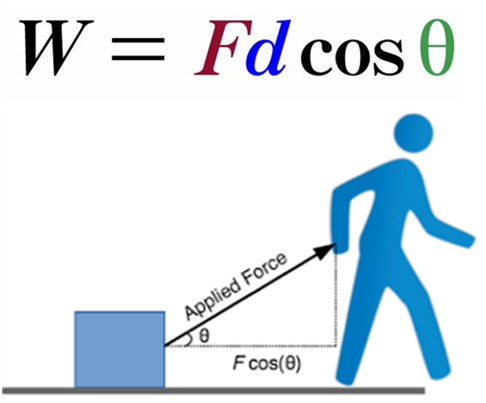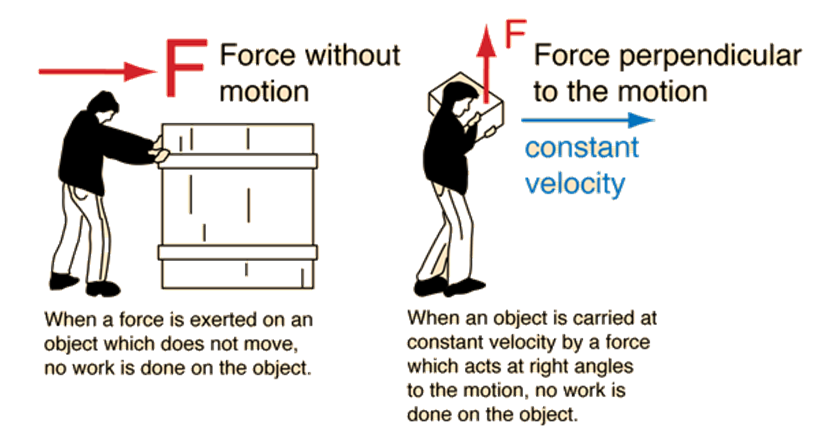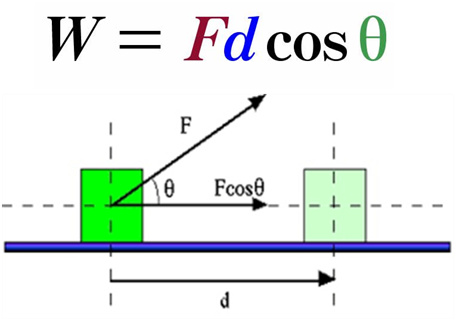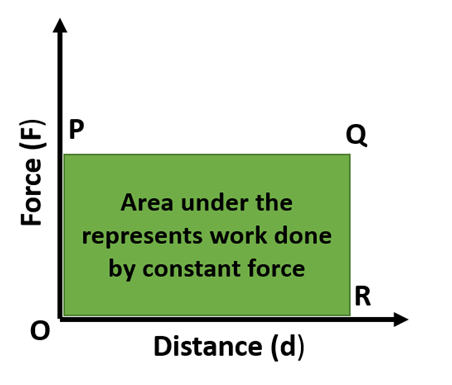Work
Work is the product of the component of the force in the direction of the displacement and the magnitude of this displacement.
work, in physics measure of energy transfer that occurs when an object is moved over a distance by an external force at least part of which is applied in the direction of the displacement. If the force is constant, work may be computed by multiplying the length of the path by the component of the force acting along the path.
To express this concept mathematically, the work W is equal to the product of force and the distance d,

Work done on a body is equal to the increase in the energy of the body, for work transfers energy to the body. If, however, the applied force is opposite to the motion of the object, the work is considered to be negative, implying that energy is taken from the object.
Positive, negative and zero work done
The work done by a force on an object can be positive, negative, or zero, depending upon the direction of displacement of the object with respect to the force. For an object moving in the opposite direction to the direction of force, such as friction acting on an object moving in the forward direction, the work done due to the force of friction is negative.

Positive work: when the force is along the displacement or angle θ between force and displacement is acute.
Example of positive work:
- Players kicking the football in the direction of motion.
- A nurse moves the patient into a wheelchair.
- A person riding a skateboard.
- Vehicles on the road, moving forward.
- Cutting the vegetables using the knife.
- Lifting the chair and moving it in another direction.
- Moving a box across the table.
- Two children throwing a ball at each other.
Negative work: when the force is opposite to the displacement or angle θ between force and displacement is obtuse.
Example of negative work
(i) When a body is thrown upwards, gravity does the negative work. Since the gravitational force acts downwards but the displacement is upwards.
(ii) When we walk frictional force does the negative work since frictional force acts opposite to displacement.
(iii) For a liquid flowing, viscous force does the negative work since it acts opposite to the direction of the force.
(iv) On a see-saw, negative work is done since we apply the force downwards but the person sitting opposite to us is displaced upwards.
Zero work done:
An object experiences zero work when
- The angle of displacement is perpendicular to the direction of the force
- when the force applied couldn’t produce motion.

Consider an example of a coolie lifting a mass on his head moving at an angle of 90˚ with respect to the force of gravity. Here, the work done by gravity on the object is zero.
Work done by constant force
Work done by a constant force is defined as the distance moved
multiplied by the component of force in the direction of displacement.

The area under the graph of force and displacement gives the value of work done by the force.

Example of work done by a constant force
- Work done by gravity
- When we apply a constant force F on a book and it moves.
- Motion of ball falling toward the ground.
Work done by a variable force
Variable force occurs when the direction and amount of a force vary throughout the motion of a body. Magnetic force, spring force, and electrostatic force are examples of variable forces. The majority of the forces we experience in our daily lives are variable forces. By splitting displacement into tiny intervals, the work done by a variable force may be computed.
A force is said to perform work on a system if there is displacement in the system upon application of the force in the direction of the force. In the case of a variable force, integration is necessary to calculate the work done.
The work done by a constant force of magnitude F, as we know, that displaces an object by Δx can be given asL:
W = F.Δx

In the case of a variable force, work is calculated with the help of integration.
The work done by force can also be calculated from the graphical method. The area under the curve in the graph of force vs displacement will give the magnitude of work done by the force.
For example, in the case of a spring, the force acting upon any object attached to a horizontal spring can be given as:
Fs = -kx
Where,
- k is the spring constant
- x is the displacement of the object attached
We can see that this force is proportional to the displacement of the object from the equilibrium position, hence the force acting at each instant during the compression and extension of the spring will be different. Thus, the infinitesimally small contributions of work done during each instant are to be counted in order to calculate the total work done.
The integral is evaluated as:


 Madhava Publications
Madhava Publications
